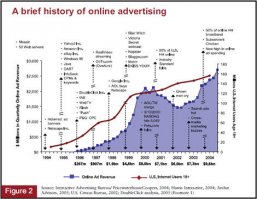From its humble beginnings as a limited experiment, online advertising has now grown into a multi-billion dollar industry and is expected to be $185.4 billion in market size by 2017. It is also predicted that digital media ad spend will surpass the combined total of ad spend on newspapers and magazines in 2015. Online ad targeting has come a long way in the past decade and continues to grow and evolve.
The Early Days
Early advertising had limited targeting capabilities. If you were to sell flight tickets to travelers, you had to search for websites that you thought they might frequent — such as the travel section of the New York Times — and then buy advertising space on each of those sites. Although this was better than no targeting at all, it was crude at best.
The first company to provide a pay-for-placement search service, GoTo.com (later rebranded as Overture), launched in 1997 and marked the beginning of the pay-per-click (PPC) bidding system in search. After helping portals like MSN and Yahoo successfully monetize their web searches, Overture was acquired by Yahoo in 2003. Meanwhile, Google was strengthening its market position in search with the launch of AdWords in 2000.
A Growing Market
According to the Internet Advertising Bureau, internet advertising is second only to Broadcast Television advertising in the dollars spent, surpassing even cable television advertising. According to PwC, search currently leads the online advertising space at $49.1 billion in 2013 ad revenue. Display advertising was not far behind with a revenue of $33.9 billion, accounting for 29 percent of the total revenue for all categories of online advertising. This represents an increase of 72 percent over 2008 display ad revenue of $19.7 billion.
Display ad revenue is expected to continue to grow at an annual growth rate of 10 percent over the next three years, reaching nearly $50 billion in 2017. Such industry forecasts suggest that online advertising will continue to play a significant role in companies’ marketing efforts.
Ad Targeting in Today’s Digital World
The core reason that targeting has come so far from its initial stage is due to the massive increases in computing power. This has allowed advertisers to make decisions on which ad to show to whom within a tenth of a second. This ability, called real-time bidding, gave advertisers a heretofore unmatched insight into consumer behavior, allowing them to reach the right audience with targeted ads based on specific intent actions.
The combination of computing power and the ability to target individual browsers allows advertisers to customize ads shown to consumers based on things like their behavior on your site, or data from third party sources. This unprecedented access to consumer behavior and intent data has also proven to be especially valuable in prospecting. Brands now have the opportunity to attract new customers, who already look like their best existing customers, by utilizing this data.
While these approaches started in search and later came to display, they are taking over other types of online media at a faster and faster rate. With the demand for high-impact video advertising exceeding the available inventory, look for the online video market to continue its strong monetization momentum – particularly as the types of one-to-one targeting used in display rapidly comes to video. In 2012, the online video-advertising market’s expansion represented a 33 percent year-on-year growth, and it is set to continue to grow at a 26 percent annual growth rate until 2017. Spending on mobile advertising is also expected to take off and eventually account for 15 percent of all Internet advertising revenues in 2017.
Since the birth of display ads and search, the online advertising industry has expanded to offer advertisers a wider variety of mediums. Currently the world’s second-largest advertising medium, online advertising is expected to experience an overall increase of 18.5 percent in spending from 2012 to 2017. The industry’s progression will undoubtedly give rise to novel ways to target consumers in the digital space, allowing brands to more effectively reach the right audience and drive conversions.





![[PDF] Adland: A Global History of Advertising Download Online](/img/video/pdf_adland_a_global_history_of.jpg)




